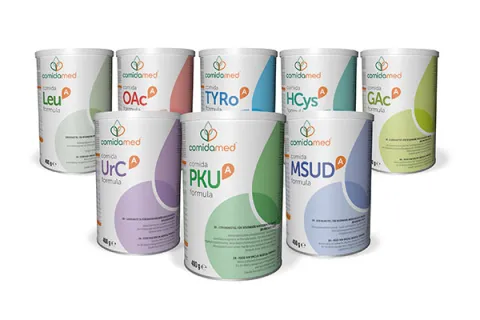A practical guide to the introduction and use of comida-MSUD A formula
This practical guide is for the use of comida-MSUD A formula in the dietary management of an infant with Maple Syrup Urine Disease (MSUD).
- comida-MSUD A formula must only be used under medical supervision.
- Suitable from birth to 12 months of age.
- Not suitable for use as a sole source of nutrition.
- comida-MSUD A formula must only be consumed by infants with proven Maple Syrup Urine Disease.
- comida-MSUD A formula must be used in conjunction with breast milk or infant formula to provide the isoleucine, leucine, valine, fluid and general nutritional requirements of the infant in quantities as advised by a metabolic healthcare professional.
- For enteral use only.
The information contained in the practical guide is for general information purposes only and does not constitute medical advice. The practical guide is not a substitute for medical advice or care provided by a licensed and qualified healthcare professional and Vitaflo does not, in the absence of negligence on Vitaflo’s part, accept any liability arising from reliance on information contained in this guide and or the incorrect use of comida-MSUD A formula product.
This practical guide should be read in conjunction with local, national and international guidelines and best practice for the dietary management of Maple Syrup Urine Disease. Information contained within the guide is based on the most recent scientific evidence available on the management of / use of Maple Syrup Urine Disease as of date of publication.
This practical guide does not establish or specify particular standards of medical care for the treatment of any conditions referred to in this practical guide.
Vitaflo International Limited does not recommend or endorse any specific tests, procedures, opinions, clinicians or other information that may be included or referenced in this practical guide.
| Symbol | Abbreviation | Definition |
|---|---|---|
| HM | Human milk | |
| BF | Breastfeed | |
| HCP | Healthcare Professional | |
| MSUD | Maple Syrup Urine Disease | |
| BCAA | Branched-chain amino acid | |
| LEU | Leucine | |
| phe-free formula | BCAA-free formula (comida-MSUD A formula) | |
| SIF | Standard infant formula |
1.0 Overview of feeding an infant with MSUD.
1.1 Nutrition prescription using comida-MSUD A formula at diagnosis.
1.3 Checklist for blood BCAA monitoring.
1.4 Fine-tuning the nutrition prescription.
2.0 Practical feeding strategies to use with caregivers.
2.1 Practical points for effective communication between HCPs and caregivers.
3.0 References.
1.0 Overview of feeding an infant with MSUD
Newly diagnosed infants with MSUD are prescribed a BCAA-free formula (comida-MSUD A formula) as soon as diagnosis is confirmed and as medically appropriate pending the clinical status of the infant. The branched chain amino acids (BCAAs – offending amino acids) consist of leucine, isoleucine, and valine.
Feeding an infant with MSUD is a balance between providing BCAA-free infant formula alongside adequate amounts of BCAA from human milk (HM)/ standard infant formula (SIF), with the goal of keeping leucine (LEU) levels within target therapeutic range. The goal range for leucine is 75-200 μmol/L for infants and children less than 5 years of age, and 75-300 μmol/L for those greater than 5 years of age1.
LEU is the offending amino acid that is tightly controlled because it has proven toxicity to the brain, whereas the other two BCAAs, isoleucine (ISO) and valine (VAL), have not been proven acutely dangerous at higher plasma levels.
ISO and VAL, are usually supplemented outside of formula to maintain target plasma levels.
Given that MSUD involves an inability to break down all three BCAAs, it is safer to omit them from formula to control their levels and use additional supplementation as needed. This balance can be achieved with HM or SIF as the source of BCAAs; a family should be supported to make the appropriate choice for their family and their infant, with relevant healthcare professionals’ input as appropriate.
comida-MSUD A formula may be used from diagnosis in combination with HM/SIF or as a sole source of nutrition for a brief period known as an “emergency regimen” or “sick day diet” in order to achieve a rapid reduction in blood LEU levels.
An emergency regimen should only be used by the metabolic healthcare provider, if diagnostic blood LEU levels are found to be significantly elevated on laboratory results, or if presenting symptomatically and there is concern for significant LEU elevation.
It is important that blood BCAA levels are monitored very closely to prevent BCAA deficiency. Once blood LEU levels approach target therapeutic range as determined by the metabolic healthcare provider, a source of BCAA, either HM or SIF, is reintroduced and given in combination with comida-MSUD A formula.
Another example in which an emergency regimen may be used is during illness, however, in this instance family/carers should contact their metabolic healthcare provider. Illness is treated/managed by, or supported by, the metabolic healthcare provider in an urgent and individual way so will not be discussed in this practical guide.
Breast Fed Infants
Healthcare providers should support a family’s decision to BF or provide HM as the intact protein source for an infant with MSUD whenever possible. comida-MSUD A formula combined with bottle-fed HM or feeding at the breast is able to maintain satisfactory blood LEU control provided there is adequate HM available for the infant and blood BCAA levels can be closely monitored1,2.
Feeding at the breast may not always be possible with MSUD. Families should discuss what is best for them and their infant with their metabolic healthcare provider. HM offers nutritional benefits including higher long chain polyunsaturated fatty acid concentrations and a lower LEU content (104 mg/100 ml in HM3 compared with approximately 154 mg/100 ml in SIF4).
Breastfeeding an infant with MSUD is based on the principle of giving a measured volume of comida-MSUD A formula to offset the infant’s appetite for breastfeeds.
Feeding a measured amount of comida-MSUD A formula alongside each breastfeed, or alternating measured feeds of comida-MSUD A formula with breastfeeds, decreases the total amount of HM consumed and therefore decreases total BCAA intake.
Infants can still feed on demand, varying the quantity of feeds from day to day provided that the prescribed quantity of comida-MSUD A formula is given throughout the day2.
Successful MSUD management with breastfeeding is achieved via close monitoring of blood BCAA levels and adjustment of the prescribed volume of comida-MSUD A formula by the metabolic healthcare professional in order to maintain blood BCAA control.
SIF Fed Infant
There are various options for feeding an infant with SIF and comida-MSUD A formula. With the help of healthcare providers, including the metabolic healthcare professional, families may choose a SIF supplemented with DHA and ARA that is best for their infant and family circumstances.
SIF and comida-MSUD A formula may be given in separate or mixed bottles pending specific clinic protocol and preference, with a variety of feeding approaches capable of optimizing blood BCAA control and catering to a family’s individual circumstances.
Blood PHE Level Monitoring
Blood LEU levels are used to determine whether the volume of comida-MSUD A formula and HM/SIF should be adjusted; as discussed earlier, LEU is the most dangerous BCAA to the brain.
Expect to adjust the feeding plan weekly, especially during the first two months of life.
Blood BCAA levels should be checked at least weekly throughout infancy1.
The quantity of LEU tolerated by infants will vary and be guided by blood LEU levels. Individual LEU tolerance will vary significantly throughout infancy with changes in growth and development.
It is vital to investigate all the possible causes for changes in LEU level before adjusting the feeding plan. Consider waiting for two consecutive blood BCAA levels to indicate the need for a feeding plan adjustment, unless the blood LEU level is very low or very high.
Progression
A combination of HM/SIF and comida-MSUD A formula and may continue to provide 100% of the infant’s nutrition requirements until the age of 6 months, or when the infant is developmentally ready for the introduction of solids.
Complementary feeding should be supported by the metabolic healthcare provider.
Important Notice
Breastfeeding can continue for as long as the mother and infant wish, provided that growth and blood LEU levels are satisfactory.
SIF should be introduced if there is inadequate HM to provide enough BCAA or liquid nutrition volume for age, in combination with comida-MSUD A formula.
If the mother wishes to wean the infant from HM, then a gradual approach is recommended, if possible.
Principles of initiating nutrition management
Monitor blood BCAA levels weekly or more frequently as needed to achieve stability in blood LEU; treatment range of 75-200 μmol/L for infants and children less than or equal to 5 years of age1.
If LEU levels > 200 μmol/L and if medically appropriate given clinical status after diagnosis, implement use of comida-MSUD A formula.
Depending on diagnostic BCAA levels and clinical circumstances, the metabolic team may consider the following strategies for initiating.
comida-MSUD A formula:
- Temporarily stop HM/SIF and use comida-MSUD A formula as sole nutrition source for </= 48 hours.
- Introduce comida-MSUD A formula in combination with HM/SIF.
Once LEU levels approach the target therapeutic range, if HM/SIF has been stopped, reintroduce to tolerance.
Intact protein intake is adjusted based on individual blood LEU levels.
For breastfed infants, comida-MSUD A formula volumes will be adjusted with the intended effect of modifying the infant’s appetite for HM.
Continue to give a combination of comida-MSUD A formula + HM/SIF to provide 100% of the infant’s requirements and to achieve optimal growth and LEU levels.
HM/SIF and comida-MSUD A formula should provide 100% of the infants’ nutrition needs until approximately the age of 6 months when solids are introduced or when the infant is developmentally ready for the introduction of solids2.
- comida-MSUD A formula and BCAA source should be given together at each feed, or at alternating feeds to ensure nutrient availability throughout the day.
- If the prescribed volume of comida-MSUD A formula is not taken, it may cause a rise in blood LEU levels, which is very dangerous for the infant.
- Blood LEU levels are used to determine whether comida-MSUD A formula, SIF/HM prescription should be adjusted.
- The infant should be weighed at each clinic visit.
1.1 Nutrition prescription using comida-MSUD A formula at diagnosis
The aim is to achieve a rapid reduction in blood Leu levels
If temporarily stopping intact protein and using comida-MSUD A formula alone to lower very high blood LEU levels, a two-step method is used:
Step 1 - Introduction of comida-MSUD A formula
- Use comida-MSUD A formula as a sole source of nutrition for 24-48 hours or until blood LEU level approaches target range as directed by metabolic medical team.
- comida-MSUD A formula should be offered on demand to the infant if medically appropriate to do so.
Feeding plan and considerations:
- Mix desired amount of comida-MSUD A formula per feed (see example feeding plans which follow).
- A 1–2 week-old infant will typically take 45-90 ml (1.5-3 fl oz) per feed.
- Encourage family to track number of wet and soiled diapers to ensure intake adequacy.
- Feeding frequency may need to be higher for infants who have not yet regained their birth weight.
- Family should consult with their metabolic healthcare professional.
- Encourage mothers breastfeeding to express breast milk when the infant feeds to establish and protect breast milk supply during the emergency regimen.
- Maternal-infant skin-to-skin contact and/or a small number of short duration breastfeeds (if approved by metabolic healthcare provider), may be continued to help promote breast milk supply and bonding during the period when breastfeeding is stopped.
Step 2 - Reintroduction of HM/SIF
- When blood levels are in the therapeutic target range.
1.2 Example feeding plan
If an emergency regimen is not required or reintroducing intact protein source, the following feeding plans illustrate 2 methods for calculating the feeding plan whether breastfeeding or bottle feeding with expressed HM or SIF.
Also note, many factors can affect blood BCAA levels. Always check for causes of high or low blood BCAA level before making a change to the nutrition prescription.
Example using a 6-day old infant diagnosed with MSUD, weight 3.5 kg.
Using precise feeding volumes |
|
|
comida-MSUD A formula & BF |
comida-MSUD A formula & expressed HM/SIF |
|
Estimate total volume intake per day using 150 ml/kg1,5 = 525 ml/day (or use infants usual total volume intake if known). |
|
|
Estimated LEU need = 40-100 mg LEU/kg/day2. Using 140 mg LEU/day: |
|
| Estimate amount of HM needed: ~135 ml HM (104 mg LEU/100 ml) HM will not actually be measured but this estimate gives a place to start |
Estimate amount of HM/SIF needed: ~135 ml HM (104 mg LEU/100 ml) ~90 ml SIF (154 mg LEU/100 ml) |
|
Estimate amount of comida-MSUD A formula needed to meet remaining fluid needs.
|
|
| 525 ml total volume – 135 ml HM = 390 ml comida-MSUD A formula per day. |
525 ml total volume – 135 ml HM = 390 ml comida-MSUD A formula per day. 525 ml total volume – 90 ml SIF = 435 ml comida-MSUD A formula per day. |
|
Divide total amount of estimated comida-MSUD A formula needed by number of feeds per day.
390 ml comida-MSUD A formula / 8 feeds per day = 50 ml comida-MSUD A formula per feed
|
Establish mixing prescription per bottle by dividing HM/SIF and comida-MSUD A formula needed per bottle*
|
|
As a starting point, try to simplify the above plans into more easily measurable quantities such as: |
|
|
60 ml (2 fl oz) comida-MSUD A formula prior to each BF. OR Alternate 120 ml (4 fl oz) comida-MSUD A formula with BF. |
Adjust amounts accordingly to make easily measurable amounts to make a total 60 ml (2 fl oz) bottles if metabolic healthcare professional feels comfortable allowing the change in LEU prescription. |
* Infants should be fed to appetite when hungry and total liquid volume per day should not be limited to establish BCAA level formula control. If the estimated volume intake does not satisfy the infant, then additional feeds either comida-MSUD A formula alone or mixed comida-MSUD A formula + HM/SIF can be given depending on what is clinically appropriate.
1.3 Check list for blood LEU monitoring
Many factors can affect blood LEU levels. Always check for causes of high or low blood LEU level before making a change to the nutrition prescription.
Considerations for high blood LEU levels:
Possible cause |
Action |
|---|---|
Excess intake of intact protein (HM/SIF) |
|
Inadequate intake of comida-MSUD A formula |
|
Catabolism or slow weight gain |
|
Change in blood monitoring routine |
Encourage consistent timing of blood LEU level within family’s and infant’s specific circumstances |
Individual amino acid supplements |
Inadequate provision of other BCAAs (isoleucine and valine) can contribute to catabolism and inadequate LEU utilization. |
Considerations for low blood LEU levels
Possible cause |
Action |
|---|---|
Inadequate intake of intact protein (HM/SIF) or Excessive intake of comida-MSUD A formula |
|
Anabolism or rapid growth phase |
|
Change in blood monitoring routine |
Encourage consistent timing of blood BCAA level over the day within family’s and infant’s specific circumstances |
Monitoring tips
For all infants, frequent monitoring of BCAA levels is key, but try not to make changes to a feeding plan too frequently.
Consider:
Many factors affect BCAA levels; review all causes in this section.
- Monitor BCAA level trends
- Unless LEU level is very low or very high consider:
- Continuation of the current plan
- Awaiting 2 consecutive LEU levels before adjusting prescription
- In general, do not make more than 1 change to the plan in 1 week
For LEU levels that ARE very low or very high:
- Consider repeating blood LEU level sooner than 1 week to guide interventions or other intervention as recommended by metabolic healthcare professional.
Illness management
There is a risk of metabolic decompensation during trauma, surgery, illness or inappropriate dietary intake1.
Emergency regimes are individually prescribed to prevent catabolism and promote anabolism, with close monitoring of biochemical and clinical status. Refer to local and international guidelines for further information1.
1.4 Fine-tuning the nutrition prescription
For a BF infant + comida-MSUD A formula |
|
|
Action |
|
| If blood LEU is HIGH after 2 consecutive samples or after a single, very high level | If blood LEU is LOW after 2 consecutive samples or after a single, very low level |
|
|
|
EXAMPLE: infant weight 5 kg |
|
|
Current feeding regimen |
|
| 60 ml (2 fl oz) comida-MSUD A formula prior to every breastfeed ~8 breastfeeds per day Estimated comida-MSUD A formula per day = 480 ml (16 fl oz). |
|
|
Adjustment |
|
| 75 ml (2,5 fl oz) comida-MSUD A formula prior to every breastfeed (20 % increase) OR Give 1-2 full bottle feeds per day of comida-MSUD A formula only, and continue with 60 ml (2 fl oz) comida-MSUD A formula prior to remaining breastfeeds (~6-7 per day) Estimated comida-MSUD A formula per day = ~510-600 ml (17-20 fl oz). |
50 ml (1,67 fl oz) comida-MSUD A formula prior to every breastfeed (15 % decrease) OR Give 1-2 full breastfeeds per day without comida-MSUD A formula and continue 60 ml (2 fl oz) comida-MSUD A formula prior to remaining breastfeeds (~6-7 per day) Estimated comida-MSUD A formula per day = ~400-420 ml (13-14 fl oz). |
* Although a 50% increase seems high, it often coincides with a simultaneous increase in total infant feeding volume per day.
For a bottle-fed infant + comida-MSUD A formula |
|
|
Action |
|
| If blood LEU is HIGH after 2 consecutive samples or after a single, very high level | If blood LEU is LOW after 2 consecutive samples or after a single, very low level |
|
|
|
EXAMPLE: infant weight 5 kg |
|
|
Current feeding regimen |
|
| 90 ml (3 fl oz) per feed x 8 feeds per day Bottles mixed as 60 ml (2 fl oz) comida-MSUD A formula + 30 ml (1 fl oz) SIF Estimated comida-MSUD A formula per day = 480 ml (16 fl oz). |
|
|
Adjustment |
|
| 75 ml (2,5 fl oz) comida-MSUD A formula + 15 ml (0,5 fl oz) SIF Estimated comida-MSUD A formula per day = 600 ml (20 fl oz). |
55 ml comida-MSUD A formula + 35 ml SIF (note: this is a difficult volume for families to measure, consider alternative option) OR Give 1 full bottle per day of SIF and continue remaining bottles (~7 per day) mixed as 60 ml (2 fl oz) comida- MSUD A formula + 30 ml (1 fl oz) SIF Estimated comida-MSUD A formula per day = 420-440 ml (~14-15 fl oz). |
* If the infant is still hungry after the feed, there are different approaches that may be used to achieve satiety for the infant while maintaining blood LEU control (infants should always be fed to appetite, and total feeding volume should not be restricted to achieve LEU level control):
- Offer additional comida-MSUD A formula to achieve satiety.
- Offer additional mixed bottle of SIF/HM + comida-MSUD A formula where clinically appropriate to achieve satiety.
2.0 Practical feeding strategies to use with caregivers
Be prepared with feeding supplies. It is important for HCPs to know what supplies the family/caregivers have on-hand and to ensure they can get proper supplies when needed.
These include:
Feeding bottles with necessary measurement markings (demarcation) for infant’s recipe
- Appropriately staged nipples for infant feeding
- Adequate supply of comida-MSUD A formula
- HM pump and supplies if needed to express
- Adequate supply of SIF (if using)
Formula mixing instructions review
- Use comida-MSUD A formula scoop (or gram scale) to mix comida-MSUD A formula. Do not use scoops from other formula containers to mix comida-MSUD A formula
- Ensure family has access to a safe water source for formula mixing
- Inquire about the most effective written method for family to receive new recipes and mixing instructions. Review mixing at every visit
Confirm family/caregivers are able to procure more comida-MSUD A formula and SIF (if using) when supplies are low. Consider providing written guidance on where families can obtain these formulas. Direct families to appropriate agencies and services if needed to obtain SIF at low-cost or for free.
2.1 Practical points for effective communication between HCPs and caregivers
Establish lines of communication between HCP and caregiver/family
Phone calls, e-mail, text and/or the medical record portal may all be used. Ensure caregivers/families are comfortable using communication method.
Keep information simple and practical and check family/caregiver understanding of information
Allow time for questions and encourage questions between visits.
Consider written feeding plans.
Encourage questions
Caregivers should be encouraged to ask questions and speak up whenever they do not understand. Effective and open lines of communication as well as appropriate teaching methods are critical for caregiver success.
Educate all caregivers
Let primary caregiver(s) know that anyone taking care of the infant is welcome at clinic visits and education pieces may be provided for all caregivers depending on their needs.
Establish frequency of BCAA levels and clinic visits
Ensure caregivers understand what communication method will be used to report results and adjust the diet between visit.
Inform other HCPs, including the primary care physician, of the management plan
Direct caregivers to appropriate patient/family support groups and appropriate information platforms
Remember that different patients/families succeed with different communication methods;
Be as adaptable as you can within your clinic’s capabilities.
3.0 References
- Frazier DM, Allgeier C, Homer C, et al. Nutrition management guideline for maple syrup urine disease: An evidence- and consensus-based approach. Mol. Genet. Metab. 2014;112(3):210-217. Available from: doi:10.1016/j.ymgme.2014.05.006.
- Huner G, Baykal T, Demir F, Demirkol M. Breastfeeding experience in inborn errors of metabolism other than phenylketonuria. J. Inherit. Metab. 2004; 28(4):457-465. Available from: doi:10.1007/s10545-005-0457-3.
- Nommsen L, Lovelady C, Heinig M, Lönnerdal B, Dewey K. Determinants of energy, protein, lipid, and lactose concentrations in human milk during the first 12 mo of lactation: the DARLING Study. AJCN. 1991;53(2):457-465. Available from: doi:10.1093/ajcn/53.2.457.
- Melnik BC. Excessive Leucine-MTORC1-Signalling of Cow Milk-Based Infant Formula: The Missing link to understand Early Childhood Obesity. J. Obes. 2012;2012:1-14. Available from: doi:10.1155/2012/197653.
- Shaw V, McCarthy H. Principles of Paediatric Dietetics: Nutritional Assessment, Dietary Requirements and feed Supplementation. In: Shaw V, editor. Clinical paediatric Dietetics. 5th ed: Wiley Blackwell; 2020.
Download this practical guide
You can refer to this document later or print it for your records.
Browse other topics
Discover more from the comidamed world:



